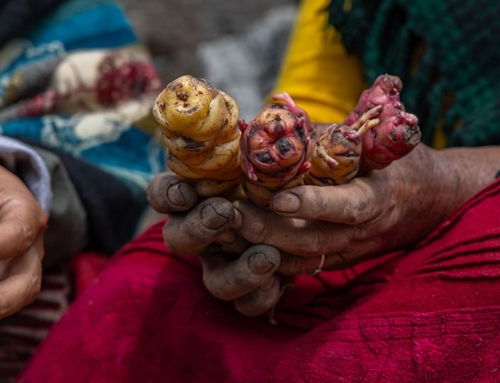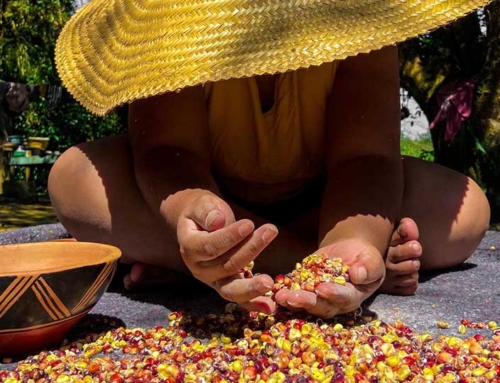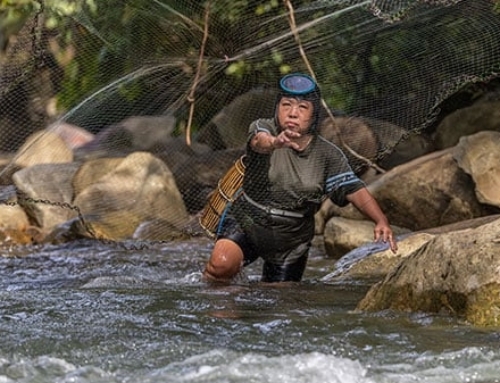The agroecological systems of farmers, growers, and Indigenous Peoples everywhere have shaped and cared for landscapes for millennia. Ecosystems that we may perceive as pristine wildernesses are in fact culturally rich, productive, and carefully managed landscapes which have supported both people and wildlife since time immemorial thanks to the stewardship of those living there.
In this blog, Synchronicity Earth Programme Officer Pria Ghosh explores how the practice of agroforestry can increase biodiversity, provide food security and help to strengthen and spread ancestral practices for the benefit of both forests and the Indigenous Peoples and cultures that sustain them.
Guarani people and the Atlantic Forest
In the Atlantic Forest of Brazil, the Guarani people are planting their seeds. These seeds, like those planted by their ancestors, hold not only food for their communities, but the foundations of rich and resilient culture, and of the Atlantic Forest itself.
The Atlantic Forest supplies fresh water to 123 million people and is home to around five per cent of the entire world’s plant and animal biodiversity. Today though, just seven per cent of the forest remains, and what is left is clinging on in small fragments, separated by expanding industrial agriculture, mines, logging concessions, and urban sprawl. The Atlantic Forest is also the ancestral homeland of two Indigenous Peoples, the Tupi and the Guarani.
Synchronicity Earth is supporting the Guarani, through Comissão Guarani Yvyrupa, in their struggle to demarcate their ancestral territories and protect the forest.
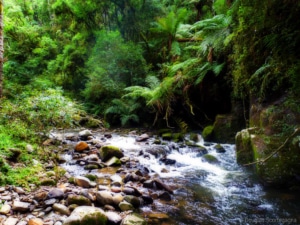
Atlantic Forest in Brazil. Image: Douglas Scortegagna CC BY 2.0
Tiago Karai, a young Guarani leader from the Tenondé Pora Indigenous land near São Paulo, explains the important relationship between their ancestral territories, their seeds, and their culture:
“Since the new boundaries’ demarcation, which recognised our rights to a much larger area, we have been able to strengthen our culture and our practices, but also recognise how much we lost when we were confined. We lost seeds. The loss of seeds meant the loss of food, sacred food, and we are only now regaining the ability to strengthen our seed stocks, our cultural knowledge, and once again protect our environment, our territory.”
– Tiago Karaí, speaking at Synchronicity Earth event ‘Indigenous lifeways for a flourishing Earth’
On lands that the Guarani have managed according to their traditions, nearly 100 per cent of the Atlantic Forest vegetation remains. The Guarani plant sacred seeds and farm within the intact forest, and their way of life has kept the environment healthy and vibrant for generations.
“To us, nothing is separate from nature… Everything that is alive, the earth, or the elements, is a part of nature and a part of us. We are one and, in this sense, we maintain our belief as Guarani people, as Indigenous Peoples, that we must continue to fight for our land, for our territory and for our nature.”
– Kerexu Yxapyry, leader of the National Articulation of Indigenous Peoples of Brazil (APIB) at ‘Indigenous lifeways for a flourishing Earth’ event.
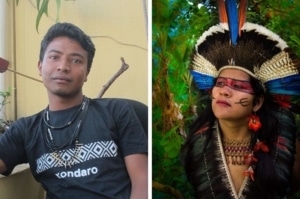
Tiago Karaí, of Comissão Guarani Yvurupa, (left) and Kerexu Yxapyry, leader of the National Articulation of Indigenous Peoples of Brazil, (right). Images © Comissão Guarani Yvurupa/Maristela-Giassi
What is agroforestry?
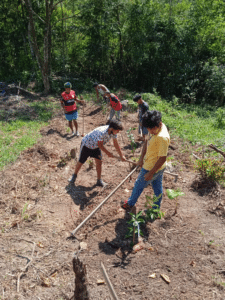
Communities engaged in agroforestry that Comissão Guarani Yvurupa is working with. Image Ⓒ Comissão Guarani Yvurupa
Agroforestry is the land management practice of growing crops and wild trees together, on the same land. The World Agroforestry Centre defines the practice as “a dynamic, ecologically based, natural resources management system that, through the integration of trees on farms and in the agricultural landscape, diversifies and sustains production for increased social, economic and environmental benefits for land users at all levels.”
The use of agroecological systems, which include not only crops grown alongside trees, but an array of natural environments, has existed for many generations, perhaps since agriculture began. They have remained critical in many parts of the world, particularly to subsistence farmers even as agriculture generally has become increasingly intensified and industrialised.
In the 1980s and 1990s, with growing awareness of the unintended damaging consequences of this intensification to soil health, biodiversity, and the land rights of local communities, scientific interest in traditional agroecological systems began to grow. Multiple studies have now shown that they are associated with numerous health, ecological, biodiversity, social and economic benefits.
Is agroforestry the answer to food security?
Food security (the availability of food and enough nutrition for the population) is a growing global concern as the impacts of climate change are already influencing global food systems.
The United Nations Food and Agricultural Organisation (FAO) now lists adopting agroforestry as an important solution to food insecurity and agriculture’s footprint on the environment. Agroforestry reduces agriculture’s contribution to climate change (and the vulnerability of crops to changing conditions), improves water quality and availability, and diversifies farmers’ incomes. As well as this, the FAO also notes that agroforestry can empower women, validate Indigenous knowledge, and improve rural livelihoods.
All around the world, from the hedgerows of Britain to the forests of the Congo Basin and the riverbanks of the Amazon, attention is finally returning to how important biodiversity is to food production and security, and what can be learned from traditional, small-scale farming practices.
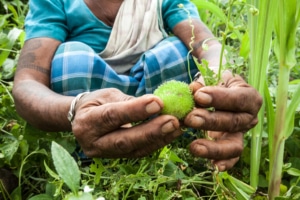
Indigenous Adivasi woman collecting fruit. Image Ⓒ Shutterstock
Our partners and agroforestry
Synchronicity Earth partners, including Comissão Guarani Yvurupa, Mbou Mon Tour, GRAIN, DGPA, AFSA, Réseau CREF, FESO, CFLEDD, and Wildlife Trust of India are showing how agroecological approaches, in many forms, can be implemented everywhere and how we will all benefit. At the international level, our partner the AgroEcology Fund (AEF) is catalysing the development of viable food systems that promote economic well-being and the human rights of small farmers and their communities through low input and sustainable agriculture around the world.
As we support agroecological approaches and agroforestry, so we support cultural and biological diversity, helping both to flourish.
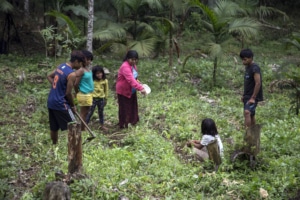
Guarani family engaged in agroforestry at Kalipety village, Tenondé Porã Indigenous Land, São Paulo, Brazil. Image Ⓒ Pedro Biava/CTI

